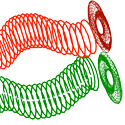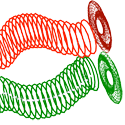Learning the ropes
In ionized environments such as the surface of the sun, magnetic field lines can become trapped in moving columns of plasma. These flux ropes can exhibit complex dynamics, and may attract or repel each other depending on the direction of current flow in the rope. In simulations and calculations, it is often assumed that if two flux ropes are attracted to one another by the Lorentz force, they will merge and annihilate. Writing in Physical Review Letters, Xuan Sun and colleagues at Los Alamos National Laboratory, US, report experimental evidence that mutually attracting flux ropes can actually bounce off each other instead of merging.
The authors studied this phenomenon at the Los Alamos Reconnection Scaling Experiment. The group created a pair of flux ropes inside the device with plasma guns and allowed the pair to evolve in three dimensions. They used a magnetic probe to map out the field strength and plasma parameters throughout the volume where the ropes were interacting. For some conditions the ropes merged as expected, but in other cases, Sun et al. observed ropes that began to merge but then separated. The Los Alamos team reports that these observations agree with a theoretical model of flux rope interaction and may have implications for understanding turbulence and energy production in astrophysical events like solar flares. – David Voss





